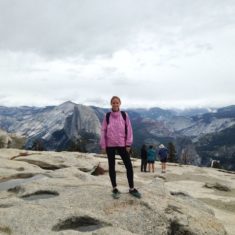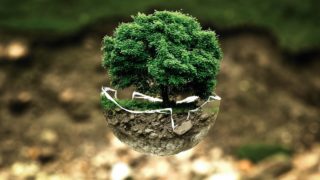Catherine Engh
Last summer, Christina Katopodis and I decided that, as co-leaders of the Ecocriticism Working Group, we wanted to work on the creation of a climate change syllabus. We felt inspired by Ashley Dawson’s Climate Action Lab and wanted to supplement that initiative with one that would yield concrete contributions to climate change pedagogy at the GC and, hopefully, beyond. We were lucky to find five brilliant and engaged collaborators, and to receive generous support from the Center for the Humanities as well as the Doctoral Students Council. In time, the project evolved from a climate action syllabus to a website (built by Christina) on teaching climate change in the humanities. As of now, the site includes seven reading lists focusing on literary and/or expository writing related to climate change. Each list stems from one or a small handful of texts and includes annotations of primary and secondary sources; some lists also offer discussion questions. The reading lists are intended as a useful resource for humanities and literature instructors who are interested in adding climate change/climate justice units to their college courses, as well as for instructors in the sciences and social sciences who might want to include a discussion of literary texts in their classes. The suggestions here are adaptable to intro level composition courses, as well as to more advanced courses in the humanities.
The project began to take shape once we decided to focus on the strengths of our contributors: rhetoric and composition, literary and cultural analysis, and media studies. Noting that much of the contemporary discourse around climate change grows out of earth systems science, geography, and political economy, we wanted to emphasize the necessity of bringing rhetorical and cultural analysis into the conversation. Some of the questions raised by our primary texts include:
- How do origin stories inform our thinking about the violence of climate change?
- What kind of future are climate activists really trying to protect?
- Can works of art help us to imagine disaster as a break from “business as usual”?
- Will the processes of settler colonialism repeat in the face of environmental upheaval?
- How might the act of listening change our understanding of what constitutes an environment?
- How do we balance geopolitical climate activism with more local concerns?
- What might empathy bring to our climate politics?
Hearing our contributors discuss their lists was by far my favorite part of the process. I’ll provide a brief overview of some of what I’ve gathered from these discussions. Eric Wilson’s list centers on Rebecca Solnit’s Climate Change is Violence. Crucial here is the question of how we describe environmental degradation. Solnit’s essay explores the slippery environmental rhetoric of both institutions and corporations. Eric recommends teaching Solnit alongside Rob Nixon’s The Environmentalism of the Poor. The Introduction to Nixon’s book gives an overview of the ways that the climate crisis enacts “slow violence” against vulnerable populations, and the subsequent chapters explore how the “fast, dramatic narratives of Hollywood” might be circumvented to address the diffuse temporalities of environmental violence. Megan Wiessner’s list on environmental manifestos also focuses on popular ways of framing climate crisis. Megan notes that rarely are the stakes of climate action so frankly laid out as in these manifestos. Because the manifestos set very different end goals, they might prompt students to think about how historical and geographical factors shape people’s hopes for the future. My list on Ben Lerner’s auto-fictional novel 10:04 suggests that one of our goals for the future might be to be able to remember the disasters of the past. The novel represents the ordinariness of extreme weather in New York City, and could be used to frame a discussion about how art, and poetry in particular, might help us to imagine a future in which urban life is founded on some other basis than “murderous stupidity.” Henry David Thoreau aims, like Lerner, to revitalize our interest in ordinary life. Christina Katopodis assigns “Sounds” from Thoreau’s Walden to show students how nature writing affords access to local environments that we might not otherwise have access to. She accompanies the reading with an assignment that asks students to spend one hour practicing the kind of attention to the environment that Thoreau performs in Walden.
Kaitlin Mondello shares Christina’s interest in how literature might alter our disposition towards the natural world. In Octavia Butler’s Parable of the Sower, a scarcity of food and water impels calls for a new religion. Butler’s novel emphasizes the way in which creation myths help us to imagine the relations between humans and the natural world. Kaitlin recommends using the novel to generate conversation about what alternatives to Judeo-Christian myth might offer us in the context of climate change. Alexander Schlutz’s list on Chantal Bodlieu’s climate drama Sila offers another entry point into that conversation. Sila is a play about how climate scientists must work with the Inuit community in the Arctic to adapt to the realities of climate change. By merging the perspectives of climate science and indigenous myth, the play suggests the usefulness of non-Western mythologies for the task of adapting to a warming world. Louise Erdrich’s Future Home of the Living God uses the form of dystopia to speculate about what adaptation to environmental crisis might look like. In the novel, the United States government is attempting to imprison and control all pregnant people in response to the rumor that evolution is running backwards. Becky Fullan recommends pairing the novel with Kyle Powys-Whyte’s essay “Let’s be Honest, White Allies” about how white and settler conservationists are often attempting to “prevent their own future dystopias through actions that also preserve today’s Indigenous dystopias.”
The process of creating and discussing the lists reinforced our sense that climate change is not a niche issue, but one that touches a range of social, political, cultural, and environmental concerns. Because climate change informs so many different areas of inquiry, we found it necessary to keep our idea of what counts as “climate fiction,” or “climate literature” open-ended. We feel that novels like Butler’s Parable of the Sower and Dawn, Erdrich’s Future Home of the Living God, and LeGuin’s The Left Hand of Darkness, all of which do not directly address climate change, nevertheless introduce ways of thinking that are immediately relevant to it. Becky notes that “while climate change is rarely explicitly mentioned in [Erdrich’s Future Home of the Living God,] it is a background and a catalyst for all these environmental and political upheavals.”
The immediate effects of the project will be felt, as we bring the material gathered here into our classrooms. While Alexander has taught Bilodeau’s Sila and Christina has taught Thoreau’s Walden, the rest of us have not had the chance to teach the texts on our lists. Teaching will, then, allow us to test and revise our pedagogies. There is so much more to read, and we hope to add to the “Teaching Climate Change in the Humanities” site over time. I plan to add a list on The Left Hand of Darkness this summer, and Christina Katopodis is working on a list on Octavia Butler’s Dawn. Next year, we plan to add a page devoted to the eighteenth- and nineteenth-century pre-histories of environmentalism. The questions that authors in these earlier periods ask about “nature” are less determined by the disciplinary divisions between the arts and sciences that organize knowledge today. Eighteenth- and nineteenth-century nature writing raises questions about vitalism and life, sensation and reflection, evolution and degeneration, and the ethics of scientific inquiry. A page devoted to the writing of earlier periods will allow us to situate contemporary writing on climate change in relation to earlier efforts to imagine human beings’ place within and obligation to the vital world of nature.
If you would like to contribute a list to the project, please get in touch with us by emailing [email protected] and [email protected].


